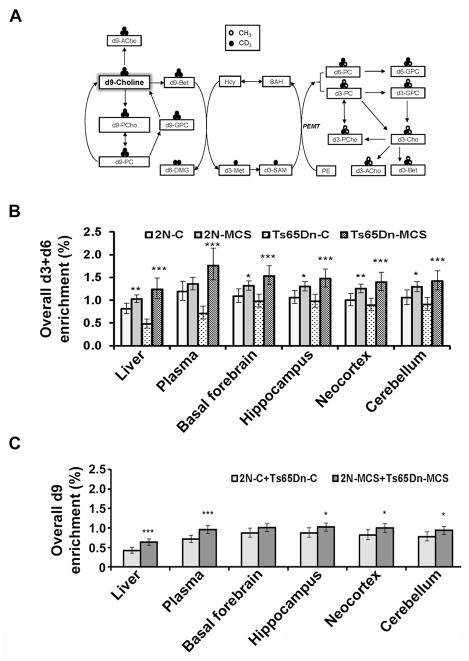Figure 3.
Effects of MCS on choline metabolites in Ts65Dn mice and 2N littermates. A: Schematic of the metabolism of the orally consumed d9-choline tracer. Intact d9-choline can be used to produce these d9-choline metabolites: d9-acetylcholine (d9-ACho), d9-betaine (d9-Bet), d9-phosphocholine (d9-PCho), d9-glycerophosphocholine (d9-GPC) and d9-phosphatidylcholine (d9-PC). Alternatively, the d9-choline tracer can be oxidized to d9-betaine and one of its three methyl groups can be donated to homocysteine (Hcy) forming d3-methionine (d3-Met) and subsequently d3-S-adenosylmethionine (d3-SAM). A main consumer of SAM is the phosphatidylethanolamine N-methyltransferase (PEMT) pathway which mediates the sequential methylation of phosphatidylethanolamine (PE) to PC (phosphatidylcholine). Under the current labeling strategy, the PEMT pathway generated d3-PC and d6-PC. These PEMT-PC labeled metabolites can then undergo hydrolysis to synthesize other metabolites including d3-ACho, d3-Bet, d3-PCho, and d3-GPC). B: Effects of MCS on overall d3+d6-enrichment in liver, plasma, and brain regions including basal forebrain, hippocampus, neocortex, and cerebellum of adult Ts65Dn and 2N offspring born to unsupplemented (C) versus supplemented (MCS) dams. C: Effects of MCS on overall d9-enrichment in liver, plasma, and brain regions including hippocampus, neocortex, and cerebellum of adult Ts65Dn and 2N offspring born to choline unsupplemented as compared to choline supplemented dams. Key, B, C: *= p≤ 0.05, **= p≤ 0.01, and ***= p≤ 0.001. Adapted from Yan et al., 2014 [57], and revised images used with permission.

